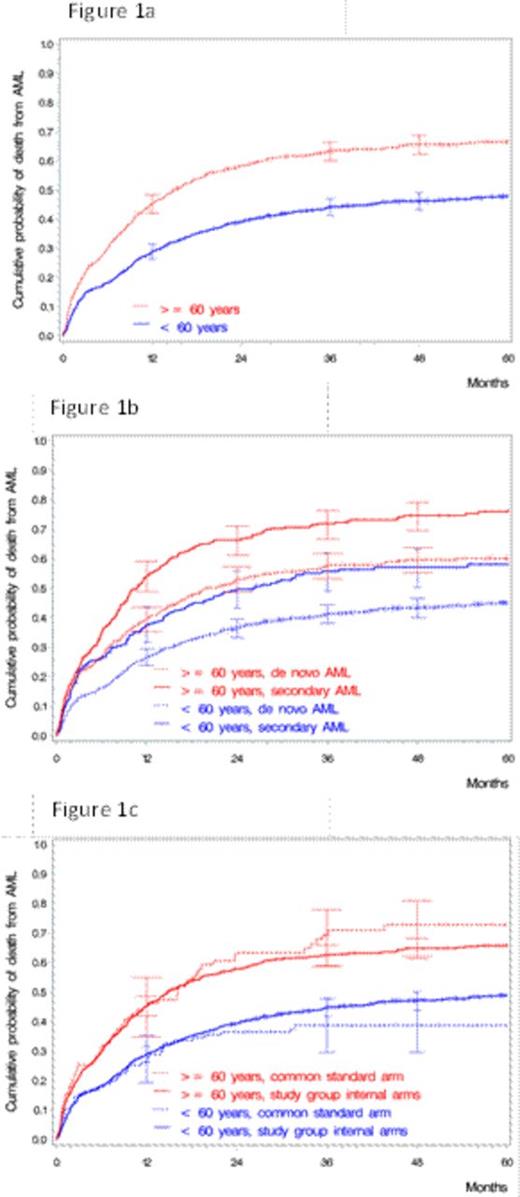Abstract
Background
The German AML Intergroup conducted two randomized studies in younger (<60 years) and elderly (≥60 years) patients in which the study arms were compared to a common standard arm. Here, we compared the two studies in younger and elderly patients focusing on disease characteristics and outcome.
Patients and Methods
The East German Study Group (OSHO) and the Acute Myeloid Leukemia Cooperative Group (AMLCG) each entered patients from 18 to 59 years into one study and patients aged 60 years and older into another. Each study group randomized upfront 10% of all AML patients into a common standard arm and 90% in the study group specific arm. All patients with de novo AML or AML after myelodysplastic syndrome or cytotoxic treatment were eligible. Chi-squared and Mann-Whitney-U tests were used to detect significant differences between the age groups regarding demographic, clinical and cytogenetic characteristics at baseline. Complete Remission (CR) at 90 days and cumulative probabilities of death were determined for outcome. To avoid bias due to the higher probability of death in older patients, cumulative probabilities of death were calculated for relapsed patients or those who did not achieve CR after 90 days. Other deaths were considered as a competing risk.
Results
A total of 2435 AML patients were analyzed, 1132 in the study <60 years and 1303 in the study ≥60 years. Significant differences in patient characteristics were noted between the studies. The elderly patient group contained a higher proportion of males than the younger group (55% vs 49% respectively, p=0.0031) and a higher percentage of secondary AML (40% vs 21% respectively, p<0.0001). In contrast, younger patients had higher median WBC count [13x109/L (range 0.03-798) for <60 years and 6.9x109/L (range 0.23-450) for ≥60 years, p<0.0001] and higher median lactate dehydrogenase [442U/L (range 35-19,624) for <60 years and 350U/L (range 51-9,486) for ≥60 years, p<0.0001]. Cytogenetic risk was similarly distributed in both groups (favorable: 12% in both age groups, intermediate: 66% in <60 years and 63% in ≥60 years, adverse: 22% in <60 years and 25% in ≥60 years, p=0.1672). However, the favorable combination of FLT3-ITDwt and NPM1mut in normal karyotype was more common in the younger (35%) than in the older group (27%; p=0.0212).
A higher rate of CR at 90 days was observed in the younger (66%) than in the older (51%) patients (p=<0.0001). Of the younger patients 14.8% died (3.8% with persisting AML, 3.3% without AML and 7.7% without evaluable disease status) while of the older patients 21.8% died (6.2% with persisting AML, 2.5% without AML and 13.1% without evaluable disease status) during this period (p=0.0001). Relapse at 90 days was seen in 1% of the younger and in 2% of the older patients.
The cumulative probability of AML-related death was lower in younger patients than in older patients (p<0.0001). Of the younger patients 29% (95% CI: 26% to 31%) and 44% (95% CI: 40% to 46%) died after one and three years due to AML; in the older group the corresponding frequencies were 45% (95% CI: 42% to 48%) and 62% (95% CI: 59% to 65%; Figure 1a).
The probability of dying from AML was lowest for the younger patients with de novo AML [27% (95% CI 24% to 29%) at 1 year and 41% (95% CI 38% to 44%) at 3 years] and highest for those with secondary AML [38% (95% CI 32% to 44%) at 1 year and 56% (95% CI 49% to 62%) at 3 years (p=0.0001)], with similar differences being observed in the older patients (p=0.0001, Figure 1b).
In the younger patients, CR at 90 days was lower in the standard (58%) than in the study arm (66%, p=0.0558), while AML related death was 29% and 27% at 1 year and 44% and 39% at 3 years respectively. In the older patients CR at 90 days was 52% vs. 51%, AML related death at 1 year 45% and 45% and at 3 years 63% and 69% for study arm and standard arm, respectively (Figure 1c).
Conclusion
This analysis reveals significant differences in gender, laboratory characteristics and proportion of secondary AML in elderly compared to younger AML patients. While there was no clear difference in cytogenetic risk groups, favorable molecular markers were more frequent in younger patients. Clear differences in CR rates after 90 days of therapy and AML related death rate were seen in regard to age (<60 years and ≥60 years) and disease type (de novo and secondary AML). As the common standard arm in both of the studies was age adapted, the differences between the two age groups are likely to be related to disease biology.
Niederwieser:Novartis: Membership on an entity's Board of Directors or advisory committees, Speakers Bureau. Hoffmann:Novartis Oncology Europe: Research Funding. Krug:Sunesis; Clavis Pharma; usa Pharma, Catapult Cell Therapy, Gilead, Roche: Membership on an entity's Board of Directors or advisory committees; Sunesis: Speakers Bureau; Boehringer Ingelheim: Research Funding; Novartis; BMS; Roche; Boehringer Ingelheim; Bayer: Honoraria. Hegenbart:Janssen: Honoraria, Other: travel support. Pfirrmann:Novartis Pharma: Consultancy, Honoraria; BMS: Consultancy, Honoraria. Kraemer:TEVA: Other: travel support. Al-Ali:Celgene: Honoraria, Research Funding; Novartis: Consultancy, Honoraria, Research Funding.
Author notes
Asterisk with author names denotes non-ASH members.


